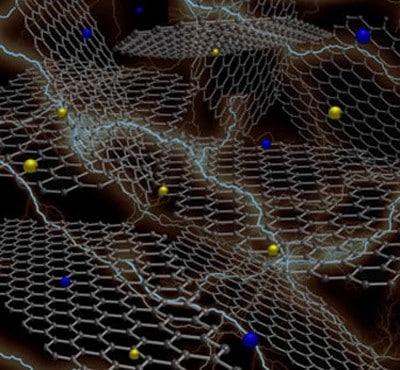
A routine laser-writing technique has been used to create sheets of graphene on the surface of a DVD. The work was done by researchers in the US, who then joined the sheets together to make electrochemical capacitors (or supercapacitors). The devices can store as much energy as a conventional battery but can be charged 100–1000 times faster. According to the researchers, the capacitors are completely flexible and robust, which makes them ideal energy-storage systems for flexible and portable electronics.
Electrochemical capacitors – also known as supercapacitors or electric double-layer capacitors – can store much more electrical charge than standard capacitors. This is thanks to the double layer formed at an electrolyte–electrode interface when voltage is applied to the device. Although promising energy-storage materials, supercapacitors still lag behind traditional batteries in terms of energy densities: 4–5 Wh/kg and 10–150 Wh/kg, respectively. They do, however, have a much longer shelf – and cycle life than batteries and can deliver large amounts of energy much more quickly.
Now, a research team led by Richard Kaner and Maher El-Kady at the University of California, Los Angeles, says that they have developed a graphene-based device that combines both the power performance of capacitors with the high energy density of batteries. The researchers have come up with a new process that involves coating an ordinary DVD with a film of graphite oxide supported on a sheet of plastic.
Brown fades to black
Kaner and colleagues begin by reducing the graphite oxide to graphene using a standard “LightScribe” DVD drive head – usually used optically to etch labels and images on DVD discs. The process can easily be monitored as the golden-brown-coloured graphite oxide turns into black-coloured graphene. The graphene-coated plastic is then peeled off and cut with scissors to make different devices (see video below).
The graphene sheets can be used as electrodes without the need for any additional binders or additives. Electrochemical capacitors are made by simply “gluing” together two identical pieces of graphene sheet with a little polymer gel electrolyte that is placed between them. “We also tested a variety of other electrolytes confirming that the material can be used in a number of device systems for different applications,” says Kaner.
Large surface area
The LightScribe graphene sheets have a large area per unit mass – greater than 1500 m2/g – which helps to increase their energy-storage capacity, and a high electrical conductivity of more than 1700 S/m. They are also flexible mechanically and can be bent thousands of times without suffering any damage to their electrical properties. All of these characteristics make them ideal not only for making supercapacitors but also for a host of other electronic devices, says El-Kady, who also lectures at Cairo University.
The LightScribe process overcomes another important problem, too, in that it produces non-stacked graphene sheets. Graphene sheets have a natural tendency to stack during production, something that reduces the overall surface area of the material.
“We believe that our work will help pave the way to making flexible supercapacitors for use in bendable electronic equipment for the upcoming boom in flexible portable electronics,” El-Kady tells physicsworld.com. “Applications include roll-up computer displays, wearable electronics that harvest and store energy produced by body movement, electronic wallpaper and energy-storage systems that can be combined with flexible photovoltaic cells.”
The team now plans to look at scaling up their production technique in a cost-effective manner. “Our initial calculations show that the price of the precursor, graphite oxide and the whole process is completely viable for commercial applications,” adds El-Kady.
Details of the current work are published in Science.



